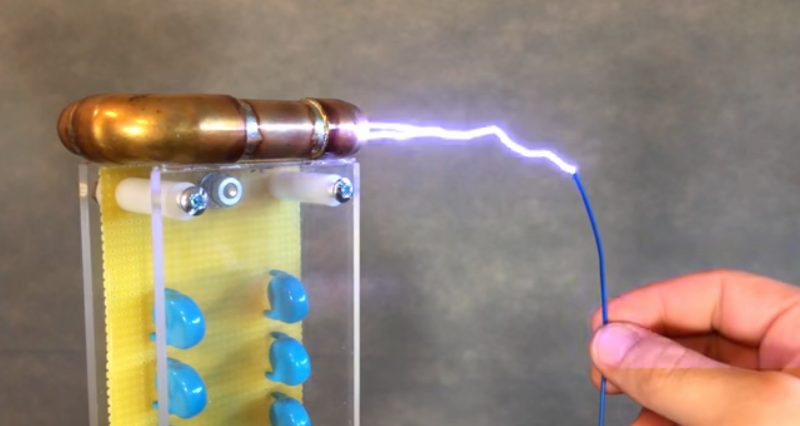Generating high voltages isn’t too hard. A decent transformer will easily get you into the 100s of kilovolts, provided you’re a power company and have access to millions of dollars and a substation to put it. If you want to go above that then things start getting difficult, and most tend to look in other places for high voltages such as voltage multipliers.
These devices use nothing but capacitors and diodes, as [Jay] from [Plasma Channel] shows us how to build a small desktop version of a voltage multiplier that can produce almost 70 kV. That’s enough to throw a substantial spark, powered by nothing but a rechargable battery found in an electric lighter. They can also be cheaper than transformers to a point, since they require less insulation and less copper and iron. The voltage multiplier works in stages, with each stage boosting the voltage to a critical level above the stage before it similar to a Marx generator.
Similar designs are used by laboratories to simulate lightning strikes, and can generate millions of volts. They’re a cost-effective way of generating huge voltage pulses and studying everything from the effects of lightning on various equipment to generating X-rays in fusion power tests. We’ve even seen them in use in lasers.
















Generating 100s of kV is not that hard, containing it and playing safely with it is the difficult bit. Give yourself a few whacks with that contraption and you will perhaps think you can survive anything.. until you don’t of course.
Wait are you telling me a hundred thousand volts is dangerous? Wow I never knew that
Nope. No where in my post did I state that a hundred thousand volts is necessarily dangerous.
Not reading carefully, or not understanding what was written, that could however prove to be dangerous.
I used to play with Cockroft-Walton multipliers, but I’ve given up that stuff. Reason? I wanted to live a bit longer. A one-transistor “tesla coil” is a much better toy, both in terms of safety and entertainment value.
Thats how some Xray generators makes 300.000V – they use a lot of Cockroft multipliers – they are good fun
I used to piddle about with arc generators based on gas burner igniter coils. Playing about with the size and shape of the upper charge accumulator can give you some wild effects. Large, spherical polystyrene balls, coated in aluminium foil, will give you huge, bright sparks, and illuminate fluorescent tubes at some distance.
The thing with voltage multipliers is they are fine for things where you need little current or short bursts of current, but as soon as you need any current they start to suck badly and, sadly, larger parts have larger parasitic infulences so the bang for the buck goes down pretty quickly.
Well yeah, power must be conserved. If you want to generate astronomical voltage using leftover bits and a battery, AND you want a lot of current? Sorry pal, I’d love a free lunch too but no dice.
There’s also the automotive ignition coil and IGBT method, depending on exactly what you keep in your boxes of leftover bits.
High currents at high voltages means UV-C generation which literally shreds DNA. It is used as a germicidal, and breaks down most chemical bonds and it also produces ozone (which at ~50 ppm for half an hour will kill). So even if you are not shocked, best to avoid unless you know what all potential risks.
Even low voltage and high current generates UV-C
Im just wondering if those marks on his left hand fingers are electric burns or soldering burns ?
.. or caused by flying rapidly backwards, landing heavily on his ar$e and throwing out his hand in to the nearest sharp object.. while trying to figure out what just happened.
I am basing this possibility on a similar “interesting experience” a few years ago while dismantling a small point and shoot camera and inadvertently touching the flash capacitor. Lesson learned (well probably not actually)… small battery powered devices may be small, and battery powered, but they can still kill you if you are too much of a “I know what I’m doing” smartarse.
As his father, I can tell you that those are from hitting the punching bag.
Right, an attempt to head off the “will it / it will” kill you discussion:
https://en.wikipedia.org/wiki/Electrical_injury#/media/File:IEC_TS_60479-1_electric_shock_graph.svg
Lethality (while never an absolute) (and damage) is guided by current (due to potential over impedance) and duration – how many joules are you going to take and where.
The chart pertains specifically to the effect of alternating current I of duration T passing from left hand to feet as defined in IEC publication 60479-1.
Full article for citations and references of the chart – https://en.wikipedia.org/wiki/Electrical_injury
Can’t we ???????????????????????? ban the safety kiddies from posting?! It’s really tedious.